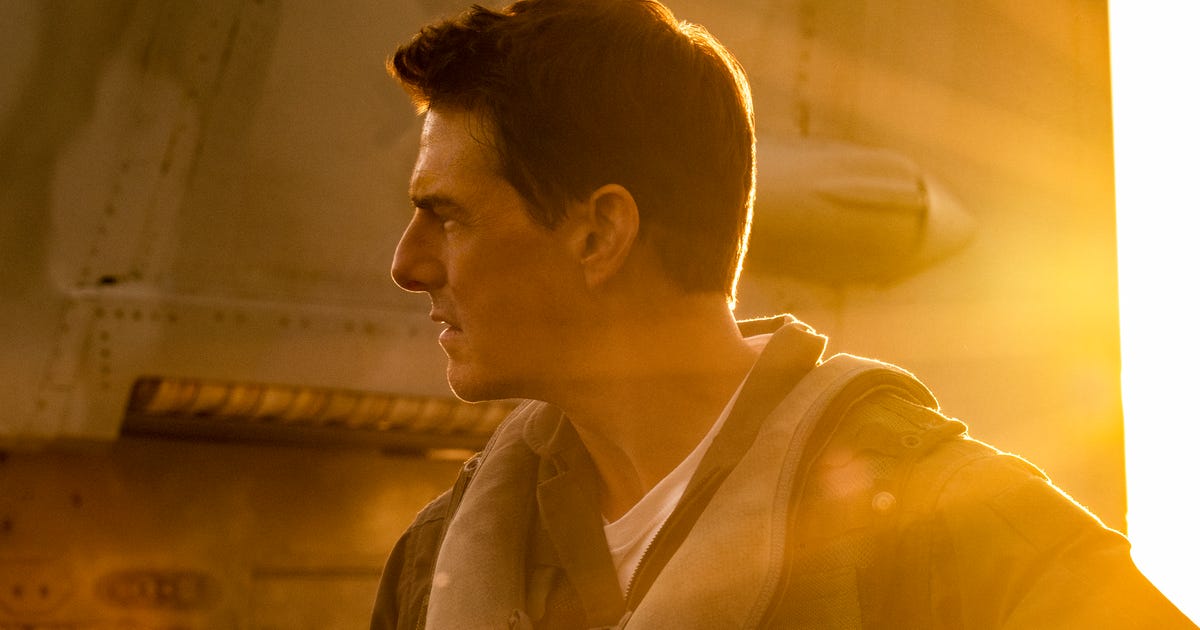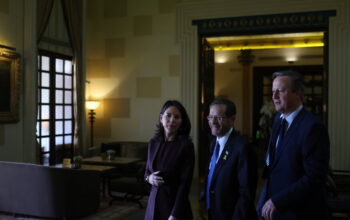
Welcome back to the danger zone. You might not think you needed a sequel to the most ’80s movie ever, but Top Gun: Maverick is way more wildly entertaining than it has any right to be. Jetting into theaters now, Top Gun 2 reboots the original film’s heart-pounding aerial action, infectiously cheesy character drama and don’t-think-too-hard-about-it military fetishism in a winning spectacle of cinematic escapism.
It’s been more than 35 years since the release of original Top Gun, in which Tom Cruise employed his widest grin as a US Navy aviator with a point to prove and a childlike delight in playing with high-speed toys (which just happen to be built for killing people, but whatever).
Cruise reportedly resisted a sequel for decades, but it turns out if you wait long enough a story presents itself. He returns to the cockpit as Pete “Maverick” Mitchell, still feeling the need for speed no matter what the top brass says. And now, enough time has passed since his co-pilot Goose’s death in the original film for Goose’s son to be a fully grown man.
Played by Miles Teller, the son is a chip off the old chock, flying under the callsign Rooster. When Maverick is called in to train the next generation of cocky kids for a Dambusters-meets-Death-Star suicide mission, the pair are locked onto an intercept course. “And we’re off,” one character wryly observes of Maverick’s anti-authoritarian antics, but he could be talking about the full-tilt re-creation of the original film’s glossy thrills.
Miles Teller is the next generation of cocky cockpit jockey in Top Gun: Maverick.
ParamountFrom the moment you hear the instantly recognizable tolling of the synth bell in Harold Faltermeyer’s stirring Top Gun Anthem, it’s like the past 30 years never happened. The opening credits describe Maverick, like the original, as a Don Simpson / Jerry Bruckheimer production, even though Simpson died in 1996. The opening text caption explaining the concept of the US Navy’s Fighter Weapons School uses the same wording as the first film. And throughout, director Joseph Kosinski and cinematographer Claudio Miranda faithfully re-create the late Tony Scott’s cinematic style, from a backlit bustling flight deck to ramrod-straight silhouettes arrayed in a hangar. This new version even begins by dropping you into the controlled chaos of an aircraft carrier flight deck with a shot-for-shot re-creation of the first film’s iconic intro (probably).
This flight deck sequence has zero connection to what comes after, but it’s still a pretty great introduction, instantly immersing you in the familiar feel of a film you may have seen many times or may not have seen for years. More importantly, it feels real, the film setting out its stall from the very beginning: It’s about real stuff, like fighter planes and sailboats and proper old-fashioned stunts, not fake stuff like drones and phones and computer-generated spectacle. The marketing makes a big deal out of how the actors really went up in planes, and while there’s doubtless a ton of invisible CGI — as in every film, whether you notice it or not — almost every shot at least feels like it was done for real. Unlike recent blockbusters (ahem, Marvel movies) which distance you from the action with clearly impossible camera angles and over-the-top CG effects, Top Gun: Maverick uses the visual language of the original, the camera jammed claustrophobically into a cockpit or shaking as it struggles to keep up with a jet screaming past.
Making this explicit connection to such a beloved movie is a risk, of course. The first film was crammed with iconic moments and quotes, and the sequel does little more than rearrange the planes on the flight deck. Still, it’s pretty restrained with the catchphrases and callbacks. Yes, Maverick’s leather jacket and motorbike get their own theme tune. But the fighter jets and aircraft carriers furnished by the United States Navy aren’t the only formidable weapons deployed by the sequel: The toppest gun in the Top Gun arsenal is Cruise’s still-explosive charisma.
While the flick again pushes credulity with its deification of Maverick and his godlike flying abilities, Cruise’s secret weapon is always his willingness to look silly. So the over-the-top action is balanced with appealing humor and even a little pathos in Cruise’s relationship with the younger flyers and his rekindled romance with a bar owner. She’s played by Jennifer Connelly, another star who rose in the 1980s (check out who’s singing on the jukebox when she first turns up). With Connelly as his old flame and Teller as his surrogate son, Cruise’s aging Maverick provides just enough heart to keep things moving as he grapples with the prospect of keeping his feet on the ground permanently. A bittersweet scene reuniting Cruise with the original film’s co-star, an ailing Val Kilmer, is also a touching and surprisingly funny moment.
Take to the skies in Top Gun: Maverick.
ParamountThere’s no disguising that a lot of the story is a rerun of the original. For example, Cruise takes the Kelly McGillis role, just for fun. But somehow, despite the fact it’s all geared toward a life-or-death mission, the stakes don’t feel as immediate as they did the first time around. The original film was fueled by the sense Maverick was genuinely dangerous to the people around him, but this new model doesn’t capture the same headlong rush into the danger zone. Partly because the younger models look more like, well, models, rather than warriors. But the main problem is that the mission is so improbably specific to the needs of the plot. The G-force of narrative silliness will start to crush your brain, especially when a late-stage twist fires the afterburners and jets into absurdity that might tempt you to eject.
There are certainly reasons not to like a film like this, whether it’s Cruise’s personal life or the film’s unquestioning attitude to war. Matthew Modine and Bryan Adams were among the ’80s stars who declined to be involved in the original because of its jingoistic tone, which was a post-Vietnam reassertion of American military (and masculine) might. Even Cruise dodged a sequel because he didn’t want to glorify war. Oddly, Top Gun: Maverick is so bloodless and untroubled by ambiguity it barely feels like a war film. It’s just boys with toys.
There’s a vague subplot about Jon Hamm’s pencil neck in the tower caring that the pilots complete the mission and not so much about them coming back alive, but that only makes the flick’s explicit disdain for unmanned combat drones somewhat confusing. In fact, a much truer Top Gun sequel was actually made a few years ago: Good Kill, in which Ethan Hawke plays a Cruise-esque fighter pilot exiled to drone duty, losing his mind in a metal box in the Las Vegas desert as he presses a button and kills civilians thousands of miles away.
Top Gun: Maverick, meanwhile, doesn’t even tell us who Tom’s fighting against. There’s an unnamed faceless adversary, black-helmeted bogeys and boogeymen, stripped of sovereignty or even humanity. The eternal enemy, somewhere out there, doing vaguely defined bad-sounding things that need to be blown up by missiles and helicopters and aircraft carriers. Your tax dollars at work.
But who cares about that? This isn’t Saving Private Ryan, this is Top Gun. Ask not for whom the synth bell tolls, because the synth bell tolls for anyone who loves a great popcorn action movie that’s as enjoyable as it is ridiculous. Top Gun: Maverick is a blast. The film keeps insisting this is Maverick’s last post, but this polished action movie powerhouse is a fun way to fly into the sunset.

